Deck 18: Native American Cultures Before 1300
Question
Question
Question
Question
Question
Question
Question
Question
Question
Question
Question
Question
Question
Question
Question
Question
Question
Question
Question
Question
Question
Question
Question
Question
Question
Question
Question
Question
Question
Question
Question
Question
Question
Question
Question
Question
Question
Question
Question
Question
Question
Question
Question
Question
Question
Question
Question
Question
Question

Unlock Deck
Sign up to unlock the cards in this deck!
Unlock Deck
Unlock Deck
1/49
Play
Full screen (f)
Deck 18: Native American Cultures Before 1300
1
What architectural feature has been found in nearly all Mesoamerican cultures?
A) A circular temple
B) A rectangular plaza with a fountain
C) An open courtyard with a kiva
D) A ball court
A) A circular temple
B) A rectangular plaza with a fountain
C) An open courtyard with a kiva
D) A ball court
D
2
Which of the following forms would support the belief that West Mexican tombs were filled with elaborate offerings?
A) Tomb sites associated with a palace
B) Deep shafts with chambers at the base
C) Shallow graves that are easily accessed
D) Tomb plaques that indicate wealth
A) Tomb sites associated with a palace
B) Deep shafts with chambers at the base
C) Shallow graves that are easily accessed
D) Tomb plaques that indicate wealth
B
3
The human-animal representations used by Olmec religious practitioners are thought to symbolize which of the following?
A) Gods of the underworld
B) Transformations to wrest power from supernatural forces
C) The dance of life
D) The creation of the Olmec dynasty
A) Gods of the underworld
B) Transformations to wrest power from supernatural forces
C) The dance of life
D) The creation of the Olmec dynasty
B
4
Which of the following does the urban plan of Teotihuacán most resemble?
A) Maya city planning
B) Anasazi city planning
C) Hellenistic and Roman city planning
D) Olmec city planning
A) Maya city planning
B) Anasazi city planning
C) Hellenistic and Roman city planning
D) Olmec city planning

Unlock Deck
Unlock for access to all 49 flashcards in this deck.
Unlock Deck
k this deck
5
What is the commonly suggested reasoning for the careful arrangement of key pyramids at Teotihuacán?
A) Related to the calendar of the gods
B) Related to astronomical phenomena
C) Related to the topography of the area
D) Related to the legend of the king
A) Related to the calendar of the gods
B) Related to astronomical phenomena
C) Related to the topography of the area
D) Related to the legend of the king

Unlock Deck
Unlock for access to all 49 flashcards in this deck.
Unlock Deck
k this deck
6
Which of the following is NOT part of the Mesoamerica region?
A) Mexico
B) Bolivia
C) Guatemala
D) Honduras
A) Mexico
B) Bolivia
C) Guatemala
D) Honduras

Unlock Deck
Unlock for access to all 49 flashcards in this deck.
Unlock Deck
k this deck
7
What is the presumed value for analysis of West Mexican ceramics, noted for the small-scale narrative scenes including temples and houses with figurines shown in a variety of lively activities?
A) They may provide a comparative assessment of Maya lifestyles.
B) They may provide economic information about trade items.
C) They provide concrete evidence of religious practices.
D) They may provide informal glimpses into daily life.
A) They may provide a comparative assessment of Maya lifestyles.
B) They may provide economic information about trade items.
C) They provide concrete evidence of religious practices.
D) They may provide informal glimpses into daily life.

Unlock Deck
Unlock for access to all 49 flashcards in this deck.
Unlock Deck
k this deck
8
The Mesoamerican Mexican Preclassic period dates to which time period?
A) 3000 BCE to CE 2000
B) 100 to 900 CE
C) 500 to 200 BCE
D) 2000 BCE to CE 300
A) 3000 BCE to CE 2000
B) 100 to 900 CE
C) 500 to 200 BCE
D) 2000 BCE to CE 300

Unlock Deck
Unlock for access to all 49 flashcards in this deck.
Unlock Deck
k this deck
9
What do art historians call Olmec carved and polished ax-shaped forms?
A) Hachas
B) Palmas
C) Datas
D) Celts
A) Hachas
B) Palmas
C) Datas
D) Celts

Unlock Deck
Unlock for access to all 49 flashcards in this deck.
Unlock Deck
k this deck
10
What significant change occurred in the early period at Teotihuacán?
A) It became the mediation center for the Maya.
B) It underwent monumental expansion into a genuine city.
C) It became an international trade center.
D) It became the pilgrimage location for the highland Maya.
A) It became the mediation center for the Maya.
B) It underwent monumental expansion into a genuine city.
C) It became an international trade center.
D) It became the pilgrimage location for the highland Maya.

Unlock Deck
Unlock for access to all 49 flashcards in this deck.
Unlock Deck
k this deck
11
Which of the following is a possible explanation for the temple-pyramid at the site of La Venta?
A) Reproduces the palace of the king
B) Is a very early form of the Maya temple-pyramid complex
C) Forms the diagram of the universe
D) Mimics the sacred mountain
A) Reproduces the palace of the king
B) Is a very early form of the Maya temple-pyramid complex
C) Forms the diagram of the universe
D) Mimics the sacred mountain

Unlock Deck
Unlock for access to all 49 flashcards in this deck.
Unlock Deck
k this deck
12
What important finds have been uncovered by recent archaeological work in West Mexico?
A) Stelae indicating trade with the Anasazi
B) Tiered platforms and ball courts
C) Maya cemeteries
D) Vases indicating trade with Tula
A) Stelae indicating trade with the Anasazi
B) Tiered platforms and ball courts
C) Maya cemeteries
D) Vases indicating trade with Tula

Unlock Deck
Unlock for access to all 49 flashcards in this deck.
Unlock Deck
k this deck
13
Which of the following has been proposed as the identity of the giant Olmec heads?
A) Maya overlords
B) Rulers
C) Deities
D) Monsters
A) Maya overlords
B) Rulers
C) Deities
D) Monsters

Unlock Deck
Unlock for access to all 49 flashcards in this deck.
Unlock Deck
k this deck
14
What does Maya architecture signify?
A) Power of the priesthood
B) Importance of the marriage alliance
C) Power of the ruler
D) Importance of the cult of the mason
A) Power of the priesthood
B) Importance of the marriage alliance
C) Power of the ruler
D) Importance of the cult of the mason

Unlock Deck
Unlock for access to all 49 flashcards in this deck.
Unlock Deck
k this deck
15
The economic foundation of Mesoamerican Mexico was which of the following?
A) Production of ceramics
B) Cultivation of wheat
C) Cultivation of maize (corn)
D) Exploitation of metal technology
A) Production of ceramics
B) Cultivation of wheat
C) Cultivation of maize (corn)
D) Exploitation of metal technology

Unlock Deck
Unlock for access to all 49 flashcards in this deck.
Unlock Deck
k this deck
16
Which of the following explains the importance of San Lorenzo and La Venta to Olmec culture?
A) Provided opportunities for the Olmec to gather and celebrate
B) Allowed the Olmec to focus on the power of the king
C) Represented the structure and ideals of Olmec society
D) Provided income for the priesthood
A) Provided opportunities for the Olmec to gather and celebrate
B) Allowed the Olmec to focus on the power of the king
C) Represented the structure and ideals of Olmec society
D) Provided income for the priesthood

Unlock Deck
Unlock for access to all 49 flashcards in this deck.
Unlock Deck
k this deck
17
Which of the following is the modern-day region that was occupied by the Classic Maya?
A) Caribbean coast of South America
B) Southwestern Mexico
C) Valley of Mexico
D) Belize, southern Mexico, Honduras, and Guatemala
A) Caribbean coast of South America
B) Southwestern Mexico
C) Valley of Mexico
D) Belize, southern Mexico, Honduras, and Guatemala

Unlock Deck
Unlock for access to all 49 flashcards in this deck.
Unlock Deck
k this deck
18
Which of the following would account for the unique cosmopolitan character of Teotihuacán?
A) The city's acceptance of all deities
B) The city's reputation as a pilgrimage site
C) The city's position on east-west trade routes
D) The city's diversified inhabitants
A) The city's acceptance of all deities
B) The city's reputation as a pilgrimage site
C) The city's position on east-west trade routes
D) The city's diversified inhabitants

Unlock Deck
Unlock for access to all 49 flashcards in this deck.
Unlock Deck
k this deck
19
How did the division of labor affect Mesoamerican societies?
A) It allowed for greater food production.
B) It provided a greater variety of foods.
C) It created a set social hierarchy.
D) It allowed more land to be cultivated.
A) It allowed for greater food production.
B) It provided a greater variety of foods.
C) It created a set social hierarchy.
D) It allowed more land to be cultivated.

Unlock Deck
Unlock for access to all 49 flashcards in this deck.
Unlock Deck
k this deck
20
At regular intervals the Olmec as a community would convene for ritual observances at which of the following sites?
A) Teotihuacán and La Venta
B) Teotihuacán and Tula
C) Copán and Tula
D) San Lorenzo and La Venta
A) Teotihuacán and La Venta
B) Teotihuacán and Tula
C) Copán and Tula
D) San Lorenzo and La Venta

Unlock Deck
Unlock for access to all 49 flashcards in this deck.
Unlock Deck
k this deck
21
Which of the following describes Temple I at Tikal (Temple of the Giant Jaguar)?
A) It is almost 150 feet below sea level.
B) It is an example of Aztec workmanship.
C) The tomb of a ruler is located beneath it.
D) It is made of cement.
A) It is almost 150 feet below sea level.
B) It is an example of Aztec workmanship.
C) The tomb of a ruler is located beneath it.
D) It is made of cement.

Unlock Deck
Unlock for access to all 49 flashcards in this deck.
Unlock Deck
k this deck
22
Which of the following describes the Tairona pendants and their use?
A) Hammered gold, badges of office
B) Shaped clay, ornaments
C) Carved wood, document receptacles
D) Hammered gold, amulets and talismans
A) Hammered gold, badges of office
B) Shaped clay, ornaments
C) Carved wood, document receptacles
D) Hammered gold, amulets and talismans

Unlock Deck
Unlock for access to all 49 flashcards in this deck.
Unlock Deck
k this deck
23
Most extant objects from the Adena and Mississippian cultures were found in which of the following?
A) Village ceremonial sites
B) Tall stone pyramids
C) Kivas
D) Burial and temple mounds
A) Village ceremonial sites
B) Tall stone pyramids
C) Kivas
D) Burial and temple mounds

Unlock Deck
Unlock for access to all 49 flashcards in this deck.
Unlock Deck
k this deck
24
We have a much better understanding of the chronology of Mesoamerica due to the deciphering of the writing and dating system of which of the following groups?
A) Aztecs
B) Maya
C) Mixtecs
D) Olmecs
A) Aztecs
B) Maya
C) Mixtecs
D) Olmecs

Unlock Deck
Unlock for access to all 49 flashcards in this deck.
Unlock Deck
k this deck
25
Which of the following is one suggested interpretation for the form of the Great Serpent Mound?
A) Route of Anasazi invasion
B) Route of Halley's Comet
C) Trail of Olmec contact
D) Teotihuacán influence
A) Route of Anasazi invasion
B) Route of Halley's Comet
C) Trail of Olmec contact
D) Teotihuacán influence

Unlock Deck
Unlock for access to all 49 flashcards in this deck.
Unlock Deck
k this deck
26
Corbeled-vaulted construction was typical of the architecture of which group?
A) Anasazi
B) Maya
C) Moche
D) Olmecs
A) Anasazi
B) Maya
C) Moche
D) Olmecs

Unlock Deck
Unlock for access to all 49 flashcards in this deck.
Unlock Deck
k this deck
27
Which of the following sites is NOT located in South America?
A) Chavín de Huántar
B) Chichén Itzá
C) Tiwanaku
D) Cuzco
A) Chavín de Huántar
B) Chichén Itzá
C) Tiwanaku
D) Cuzco

Unlock Deck
Unlock for access to all 49 flashcards in this deck.
Unlock Deck
k this deck
28
Which of the following groups is often referred to as the "mother culture" of Mesoamerican Mexico?
A) Aztecs
B) Olmecs
C) Maya
D) Mixtecs
A) Aztecs
B) Olmecs
C) Maya
D) Mixtecs

Unlock Deck
Unlock for access to all 49 flashcards in this deck.
Unlock Deck
k this deck
29
Which of the following is an explanation for the ritual of human sacrifice as evidenced at Teotihuacán?
A) Essential to kingly safety
B) Essential for the renewal of the city
C) Essential for the inheritance of power
D) Essential to agricultural renewal
A) Essential to kingly safety
B) Essential for the renewal of the city
C) Essential for the inheritance of power
D) Essential to agricultural renewal

Unlock Deck
Unlock for access to all 49 flashcards in this deck.
Unlock Deck
k this deck
30
The Mimbres culture of southwestern New Mexico was renowned for which artistic form?
A) Red clay figurines
B) Jade celts
C) Black-on-white painted bowls
D) Multicolor textiles
A) Red clay figurines
B) Jade celts
C) Black-on-white painted bowls
D) Multicolor textiles

Unlock Deck
Unlock for access to all 49 flashcards in this deck.
Unlock Deck
k this deck
31
Which of the following describes the kiva form in the North American Southwest?
A) A clay mound attached to the northeast corner of the pueblo
B) A small wooden structure located aboveground
C) A large circular semi-subterranean structure
D) A large tall stone structure located aboveground
A) A clay mound attached to the northeast corner of the pueblo
B) A small wooden structure located aboveground
C) A large circular semi-subterranean structure
D) A large tall stone structure located aboveground

Unlock Deck
Unlock for access to all 49 flashcards in this deck.
Unlock Deck
k this deck
32
The feathered serpent is one guise of which Mesoamerican Mexican deity?
A) Tlaloc
B) Coatlicue
C) Quetzalcoatl
D) Coyolxauhqui
A) Tlaloc
B) Coatlicue
C) Quetzalcoatl
D) Coyolxauhqui

Unlock Deck
Unlock for access to all 49 flashcards in this deck.
Unlock Deck
k this deck
33
Which of the following was typical of Maya art and architecture?
A) Unornamented architectural construction
B) Use of wood for sacred construction
C) Use of ribbed and groined vaults
D) Creation of huge ceremonial centers
A) Unornamented architectural construction
B) Use of wood for sacred construction
C) Use of ribbed and groined vaults
D) Creation of huge ceremonial centers

Unlock Deck
Unlock for access to all 49 flashcards in this deck.
Unlock Deck
k this deck
34
What form does a gorget take?
A) Belt
B) Spoon
C) Pendant
D) Ring
A) Belt
B) Spoon
C) Pendant
D) Ring

Unlock Deck
Unlock for access to all 49 flashcards in this deck.
Unlock Deck
k this deck
35
Which of the following was one of the purposes of Maya ritual?
A) Guaranteed the safety of the ruler
B) Guaranteed the sacrosanct nature of the ruler
C) Guaranteed the order of the state and the cosmos
D) Guaranteed the eternity of the cosmos
A) Guaranteed the safety of the ruler
B) Guaranteed the sacrosanct nature of the ruler
C) Guaranteed the order of the state and the cosmos
D) Guaranteed the eternity of the cosmos

Unlock Deck
Unlock for access to all 49 flashcards in this deck.
Unlock Deck
k this deck
36
How did Chavín iconography spread throughout the Andean region?
A) Via markers placed along the system of roads
B) Via active and itinerant missionary priests
C) Via portable media such as textiles and ceramics
D) Via permanent stelae with inscribed glyphs
A) Via markers placed along the system of roads
B) Via active and itinerant missionary priests
C) Via portable media such as textiles and ceramics
D) Via permanent stelae with inscribed glyphs

Unlock Deck
Unlock for access to all 49 flashcards in this deck.
Unlock Deck
k this deck
37
Which site did the Aztec visit with a deep sense of reverence?
A) Copan
B) Teotihuacán
C) San Lorenzo
D) La Venta
A) Copan
B) Teotihuacán
C) San Lorenzo
D) La Venta

Unlock Deck
Unlock for access to all 49 flashcards in this deck.
Unlock Deck
k this deck
38
In the 12th century, during a drought, the Ancestral Puebloans relocated to which area?
A) Painted Desert, Utah
B) Grand Canyon, Arizona
C) Four Corners region
D) Mesa Verde, Colorado
A) Painted Desert, Utah
B) Grand Canyon, Arizona
C) Four Corners region
D) Mesa Verde, Colorado

Unlock Deck
Unlock for access to all 49 flashcards in this deck.
Unlock Deck
k this deck
39
Teotihuacano murals most often depicted which of the following?
A) Ancestral spirits
B) Everyday life
C) Deities and ritual activity
D) Northern invaders
A) Ancestral spirits
B) Everyday life
C) Deities and ritual activity
D) Northern invaders

Unlock Deck
Unlock for access to all 49 flashcards in this deck.
Unlock Deck
k this deck
40
Ceramic figures from Jaina most often represented which of the following?
A) Memorials to rulers
B) Heroic figures from local legend
C) Scenes from everyday life
D) Scenes of sacrifice
A) Memorials to rulers
B) Heroic figures from local legend
C) Scenes from everyday life
D) Scenes of sacrifice

Unlock Deck
Unlock for access to all 49 flashcards in this deck.
Unlock Deck
k this deck
41
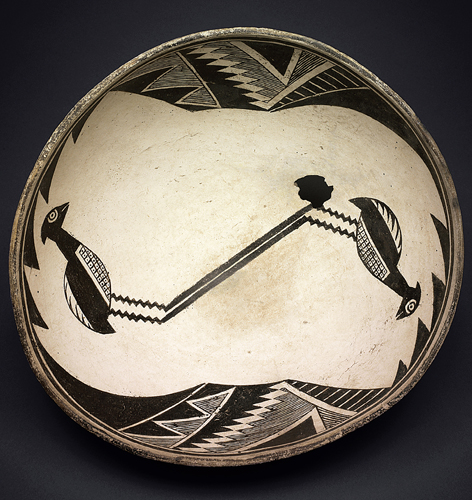
Contemporary Native American practices indicate that the potter of this vessel was likely who?
A) A child
B) A priest
C) A hunter
D) A woman

Contemporary Native American practices indicate that the potter of this vessel was likely who?
A) A child
B) A priest
C) A hunter
D) A woman

Unlock Deck
Unlock for access to all 49 flashcards in this deck.
Unlock Deck
k this deck
42
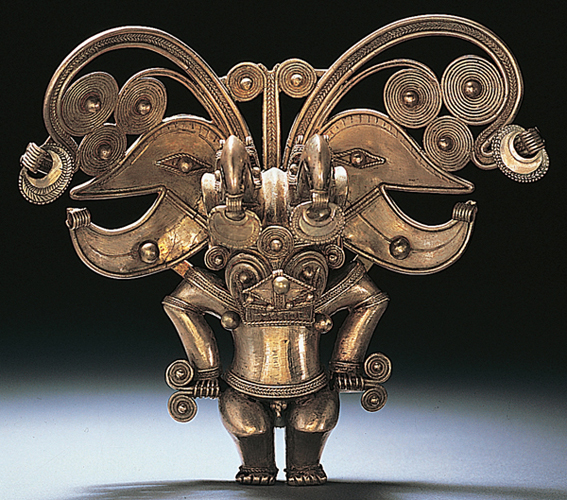
What is the subject of this Tairona gold pendant?
A) Shield Jaguar
B) Lord Pakal
C) Feathered-serpent god
D) Bat-faced man

What is the subject of this Tairona gold pendant?
A) Shield Jaguar
B) Lord Pakal
C) Feathered-serpent god
D) Bat-faced man

Unlock Deck
Unlock for access to all 49 flashcards in this deck.
Unlock Deck
k this deck
43
The Maya site of Bonampak is best known for which art form?
A) Sculpted frieze
B) Painted mural
C) Incised stele
D) Round temple
A) Sculpted frieze
B) Painted mural
C) Incised stele
D) Round temple

Unlock Deck
Unlock for access to all 49 flashcards in this deck.
Unlock Deck
k this deck
44
In the Adena culture of Ohio, what treasured item was often buried with the deceased?
A) Shield
B) Celt
C) Knife
D) Pipe
A) Shield
B) Celt
C) Knife
D) Pipe

Unlock Deck
Unlock for access to all 49 flashcards in this deck.
Unlock Deck
k this deck
45
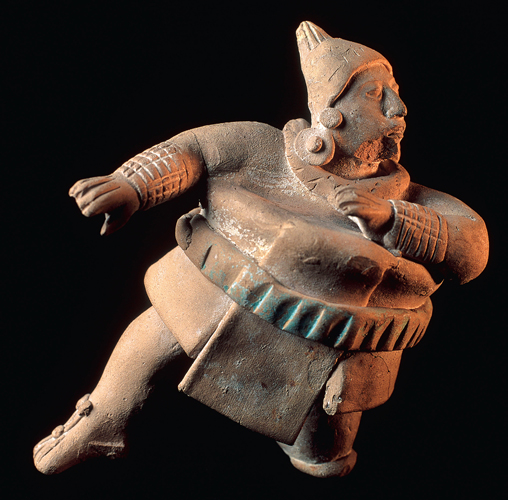
What activity is this figure taking part in?
A) Bloodletting
B) Playing ball
C) Dancing
D) Weaving

What activity is this figure taking part in?
A) Bloodletting
B) Playing ball
C) Dancing
D) Weaving

Unlock Deck
Unlock for access to all 49 flashcards in this deck.
Unlock Deck
k this deck
46

This Eskimo burial mask exemplifies what theme common to many of the early cultures of the Americas?
A) Human sacrifice
B) Centrality of women
C) Transformation
D) Hunting prowess

This Eskimo burial mask exemplifies what theme common to many of the early cultures of the Americas?
A) Human sacrifice
B) Centrality of women
C) Transformation
D) Hunting prowess

Unlock Deck
Unlock for access to all 49 flashcards in this deck.
Unlock Deck
k this deck
47
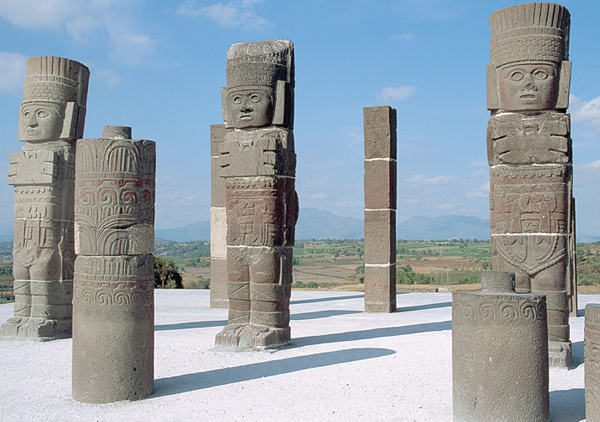
What term do art historians use to describe these Toltec male statue-columns?
A) Totems
B) Raimondis
C) Atlantids
D) Chacmools

What term do art historians use to describe these Toltec male statue-columns?
A) Totems
B) Raimondis
C) Atlantids
D) Chacmools

Unlock Deck
Unlock for access to all 49 flashcards in this deck.
Unlock Deck
k this deck
48
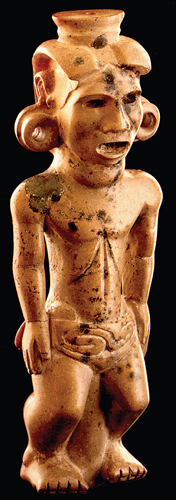
What is the function of this object?
A) Vessel
B) Pipe
C) Gorget
D) Loom weight

What is the function of this object?
A) Vessel
B) Pipe
C) Gorget
D) Loom weight

Unlock Deck
Unlock for access to all 49 flashcards in this deck.
Unlock Deck
k this deck
49
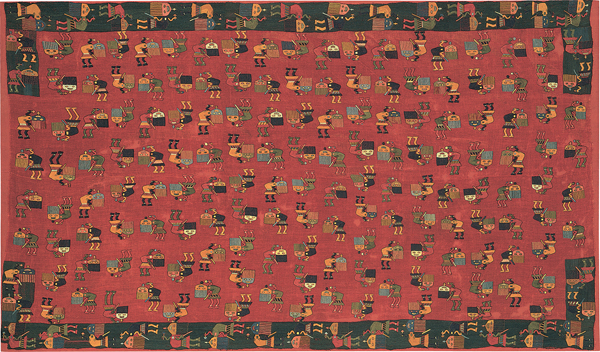
Which culture produced this embroidered funerary mantle?
A) Sipán
B) Moche
C) Paracas
D) Tairona

Which culture produced this embroidered funerary mantle?
A) Sipán
B) Moche
C) Paracas
D) Tairona

Unlock Deck
Unlock for access to all 49 flashcards in this deck.
Unlock Deck
k this deck



